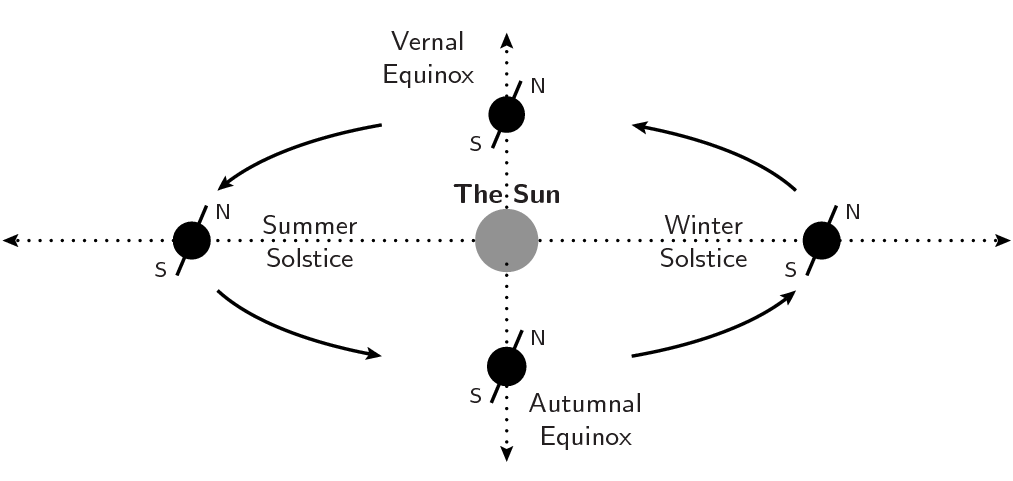December solstice
Sunday 22nd Dec 201904:05
22 December will be the shortest day of 2019 in the northern hemisphere, midwinter day.
This is the day of the year when the Sun’s annual path through the constellations of the zodiac reaches its most southerly point in the sky, in the constellation of Capricornus at a declination of 23.5°S.
On this day, the Sun is above the horizon for the less time than on any other day of the year in the northern hemisphere. This is counted by astronomers to be the first day of winter.
In the southern hemisphere, the Sun is above the horizon for longer than on any other day of the year, and astronomers define this day to be the first day of summer.
At the solstice, the Sun appears overhead at noon when observed from locations on the tropic of Capricorn, at a latitude 23.5°S.
| Date | Sunrise | Noon | Sunset | |
| 24 | Nov | 07:31 | 11:45 | 16:00 |
| 28 | Nov | 07:37 | 11:47 | 15:56 |
| 02 | Dec | 07:43 | 11:48 | 15:53 |
| 06 | Dec | 07:48 | 11:50 | 15:51 |
| 10 | Dec | 07:53 | 11:51 | 15:50 |
| 14 | Dec | 07:57 | 11:53 | 15:50 |
| 18 | Dec | 08:00 | 11:55 | 15:50 |
| 22 | Dec | 08:02 | 11:57 | 15:52 |
| 26 | Dec | 08:04 | 11:59 | 15:54 |
| 30 | Dec | 08:05 | 12:01 | 15:58 |
| 03 | Jan | 08:04 | 12:03 | 16:02 |
| 07 | Jan | 08:03 | 12:05 | 16:06 |
| 11 | Jan | 08:01 | 12:07 | 16:12 |
| 15 | Jan | 07:58 | 12:08 | 16:18 |
| Sunrise and sunset times for London See more… |
||||
Sunrise and sunset times
The table to the right lists the sunrise and sunset times in London around the solstice. In December the Earth moves slightly faster around its orbit than at other times of year due to being close to perihelion. This means that each solar day lasts fractionally longer than 24 hours, and the time of noon moves around a minute later each day.
This phenomenon is described by the equation of time.
The shift also affects sunrise and sunset times, and means that the latest sunrise and earliest sunset do not occur on the day of the solstice itself. Instead, the earliest sunset occurs a couple of weeks beforehand, and the latest sunrise is a couple of weeks later.
Solstice geometry
Solstices occur because the axis of the Earth’s spin – its polar axis – is tilted at an angle of 23.5° to the plane of its orbit around the Sun.
The direction of the Earth’s spin axis remains fixed in space as it circles around the Sun, while the Earth’s sight line to the Sun moves through the constellations of the zodiac. As a result, sometimes the Earth’s north pole is tilted towards the Sun (in June), and sometimes it is tilted away from it (in December). This gives rise to the Earth’s seasons:

The date of the solstice
| Year | Time of solstice |
| 2015 | 22 Dec 04:40 GMT |
| 2016 | 21 Dec 10:34 GMT |
| 2017 | 21 Dec 16:16 GMT |
| 2018 | 21 Dec 22:09 GMT |
| 2019 | 22 Dec 04:05 GMT |
| 2020 | 21 Dec 09:48 GMT |
| 2021 | 21 Dec 15:46 GMT |
| 2022 | 21 Dec 21:36 GMT |
| 2023 | 22 Dec 03:17 GMT |
The Earth orbits the Sun once every 365.242 days, and this is the time period over which the cycle of solstices and equinoxes, and consequently all the Earth’s seasons, repeat from one year to the next.
In any year which is not a leap year, the solstices occur roughly 5 hours and 48 minutes – just under a quarter of a day – later from one year to the next.
This is why the seasons would drift later in the year if it was not for an additional day being inserted inserted into every fourth year on 29 February.
The chart below shows the day of the month when the December solstice falls in each year. The gradual drift of the four-year cycle earlier in the month is due to the equinoxes repeating 12 minutes less than a quarter of a day later each year.
In the Gregorian calendar, this is fixed by omitting leap years in three out of every four century years, e.g. 1700, 1800 and 1900, but not 2000.
The date of Christmas
Christmas borrows its date from ancient pagan midwinter festivals, even though in the modern calendar Christmas now falls a few days after astronomical midwinter.
This anomaly has come about because the system of leap days which are sometimes inserted into our calendar on February 29 was only refined to its present form by the Gregorian calendar reforms of the 16th century. Before this, the average length of each year did not quite match the period of time with which the seasons repeat – 365.2422 days – and so the seasons drifted through the year by a small amount each century. So, in the distant past, the winter solstice occurred a few days later than it does today.
The 2019 solstice
The exact position of the Sun when it reaches its most southerly declination in 2019 will be (J2000.0 coordinates):
| Object | Right Ascension | Declination | Constellation | Angular Size |
| Sun | 17h58m | -23°26' | Sagittarius | 32'31" |
This entry in the observing calendar was provided by In-The-Sky.org
.
